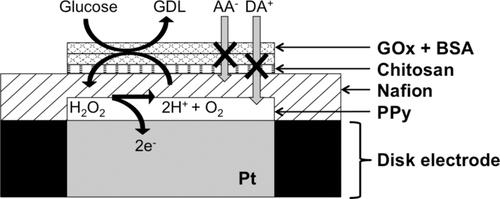当前位置:
X-MOL 学术
›
Electroanalysis
›
论文详情
Our official English website, www.x-mol.net, welcomes your
feedback! (Note: you will need to create a separate account there.)
Enzyme Deposition by Polydimethylsiloxane Stamping for Biosensor Fabrication
Electroanalysis ( IF 2.7 ) Pub Date : 2017-07-14 , DOI: 10.1002/elan.201700302 Bo Wang 1 , Bonhye Koo 1 , Harold G. Monbouquette 1
Electroanalysis ( IF 2.7 ) Pub Date : 2017-07-14 , DOI: 10.1002/elan.201700302 Bo Wang 1 , Bonhye Koo 1 , Harold G. Monbouquette 1
Affiliation

|
High-performance biosensors were fabricated by efficiently transferring enzyme onto Pt electrode surfaces using a polydimethylsiloxane (PDMS) stamp. Polypyrrole and Nafion were coated first on the electrode surface to act as permselective films for exclusion of both anionic and cationic electrooxidizable interfering compounds. A chitosan film then was electrochemically deposited to serve as an adhesive layer for enzyme immobilization. Glucose oxidase (GOx) was selected as a model enzyme for construction of a glucose biosensor, and a mixture of GOx and bovine serum albumin was stamped onto the chitosan-coated surface and subsequently crosslinked using glutaraldehyde vapor. For the optimized fabrication process, the biosensor exhibited excellent performance characteristics including a linear range up to 2 mM with sensitivity of 29.4 ± 1.3 μA mM-1 cm-2 and detection limit of 4.3 ± 1.7 μM (S/N = 3) as well as a rapid response time of ~2 s. In comparison to those previously described, this glucose biosensor exhibits an excellent combination of high sensitivity, low detection limit, rapid response time, and good selectivity. Thus, these results support the use of PDMS stamping as an effective enzyme deposition method for electroenzymatic biosensor fabrication, which may prove especially useful for the deposition of enzyme at selected sites on microelectrode array microprobes of the kind used for neuroscience research in vivo.
中文翻译:

用于生物传感器制造的聚二甲基硅氧烷冲压酶沉积
高性能生物传感器是通过使用聚二甲基硅氧烷 (PDMS) 印章将酶有效转移到 Pt 电极表面来制造的。聚吡咯和 Nafion 首先涂覆在电极表面上,作为选择性渗透膜,用于排除阴离子和阳离子可电氧化干扰化合物。然后电化学沉积壳聚糖膜以用作酶固定的粘合剂层。选择葡萄糖氧化酶 (GOx) 作为构建葡萄糖生物传感器的模型酶,将 GOx 和牛血清白蛋白的混合物压印到壳聚糖涂层表面,随后使用戊二醛蒸汽进行交联。对于优化的制造工艺,生物传感器表现出优异的性能特征,包括高达 2 mM 的线性范围和 29.4 ± 1 的灵敏度。3 μA mM-1 cm-2 和 4.3 ± 1.7 μM (S/N = 3) 的检测限以及约 2 秒的快速响应时间。与之前描述的那些相比,这种葡萄糖生物传感器表现出高灵敏度、低检测限、快速响应时间和良好选择性的完美结合。因此,这些结果支持使用 PDMS 冲压作为用于酶促生物传感器制造的有效酶沉积方法,这可能证明对于在用于体内神经科学研究的那种微电极阵列微探针上的选定位点沉积酶特别有用。和良好的选择性。因此,这些结果支持使用 PDMS 冲压作为用于酶促生物传感器制造的有效酶沉积方法,这可能证明对于在用于体内神经科学研究的那种微电极阵列微探针上的选定位点沉积酶特别有用。和良好的选择性。因此,这些结果支持使用 PDMS 冲压作为用于酶促生物传感器制造的有效酶沉积方法,这可能证明对于在用于体内神经科学研究的那种微电极阵列微探针上的选定位点沉积酶特别有用。
更新日期:2017-07-14
中文翻译:

用于生物传感器制造的聚二甲基硅氧烷冲压酶沉积
高性能生物传感器是通过使用聚二甲基硅氧烷 (PDMS) 印章将酶有效转移到 Pt 电极表面来制造的。聚吡咯和 Nafion 首先涂覆在电极表面上,作为选择性渗透膜,用于排除阴离子和阳离子可电氧化干扰化合物。然后电化学沉积壳聚糖膜以用作酶固定的粘合剂层。选择葡萄糖氧化酶 (GOx) 作为构建葡萄糖生物传感器的模型酶,将 GOx 和牛血清白蛋白的混合物压印到壳聚糖涂层表面,随后使用戊二醛蒸汽进行交联。对于优化的制造工艺,生物传感器表现出优异的性能特征,包括高达 2 mM 的线性范围和 29.4 ± 1 的灵敏度。3 μA mM-1 cm-2 和 4.3 ± 1.7 μM (S/N = 3) 的检测限以及约 2 秒的快速响应时间。与之前描述的那些相比,这种葡萄糖生物传感器表现出高灵敏度、低检测限、快速响应时间和良好选择性的完美结合。因此,这些结果支持使用 PDMS 冲压作为用于酶促生物传感器制造的有效酶沉积方法,这可能证明对于在用于体内神经科学研究的那种微电极阵列微探针上的选定位点沉积酶特别有用。和良好的选择性。因此,这些结果支持使用 PDMS 冲压作为用于酶促生物传感器制造的有效酶沉积方法,这可能证明对于在用于体内神经科学研究的那种微电极阵列微探针上的选定位点沉积酶特别有用。和良好的选择性。因此,这些结果支持使用 PDMS 冲压作为用于酶促生物传感器制造的有效酶沉积方法,这可能证明对于在用于体内神经科学研究的那种微电极阵列微探针上的选定位点沉积酶特别有用。











































 京公网安备 11010802027423号
京公网安备 11010802027423号